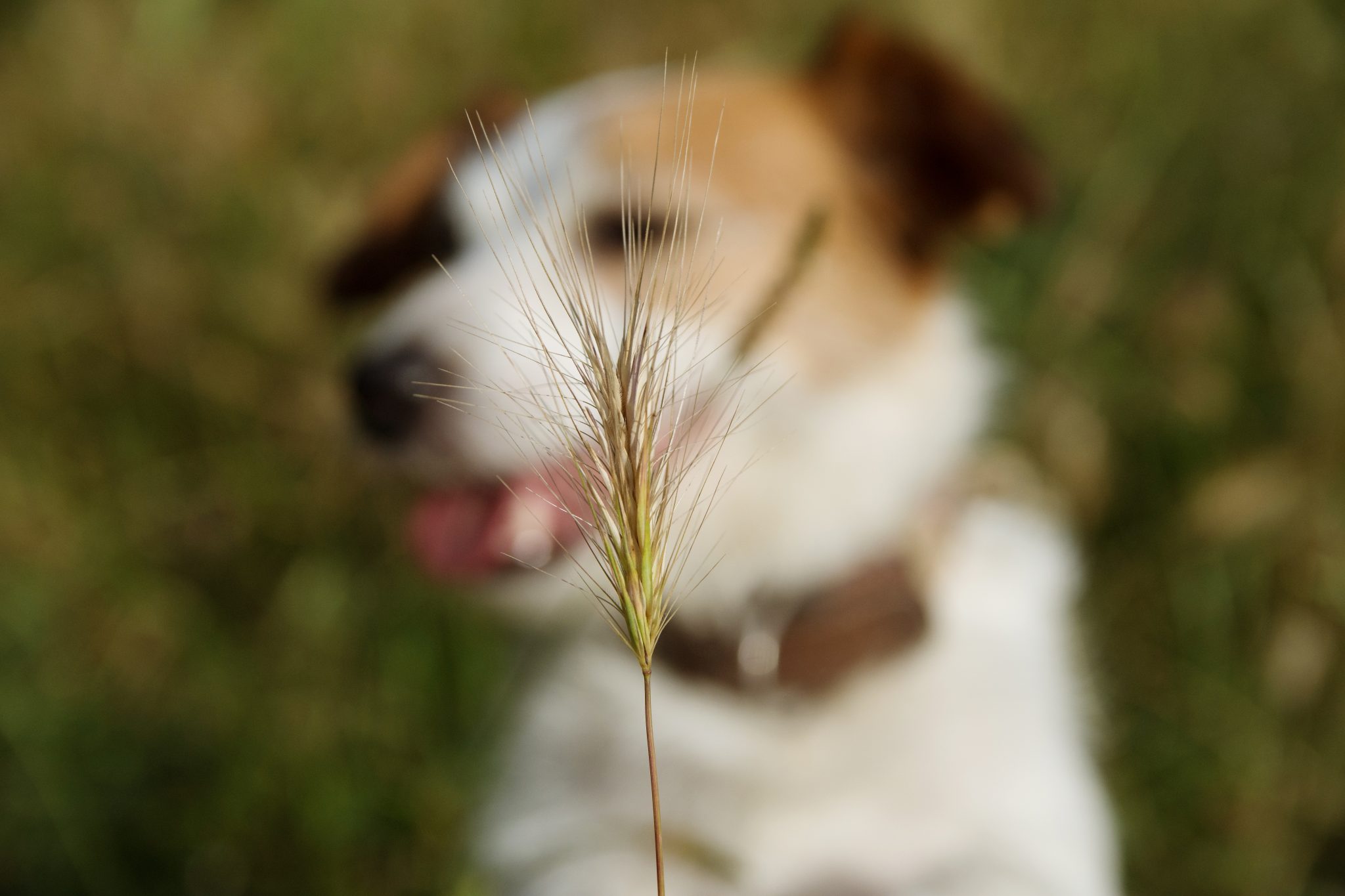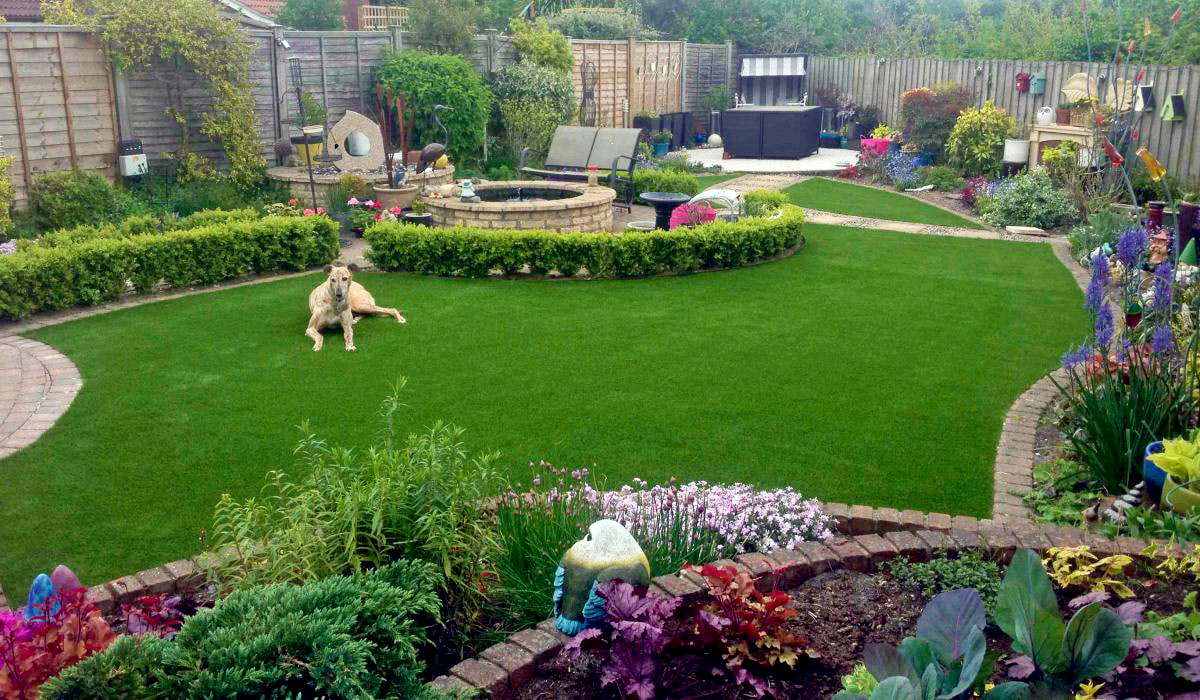Home>Garden Essentials>How To Seed Grass With Dogs


Garden Essentials
How To Seed Grass With Dogs
Modified: October 18, 2024
Learn how to seed your garden with grass even if you have dogs. Our step-by-step guide will help you achieve a beautiful and pet-friendly outdoor space.
(Many of the links in this article redirect to a specific reviewed product. Your purchase of these products through affiliate links helps to generate commission for Storables.com, at no extra cost. Learn more)
Introduction
Welcome to the wonderful world of gardening, where you can create an oasis of greenery right in your own backyard. But what happens when man’s best friend decides to make your beautiful lawn their own personal playground? If you have dogs and want to seed grass, you may face some unique challenges. Don’t worry, though, because in this article, we will guide you through the process of seeding grass with dogs and help you maintain a luscious lawn that both you and your furry friend can enjoy.
Having dogs in the house brings immense joy and companionship, but their playful nature can take a toll on your lawn. Whether it’s digging, running, or even urinating, dogs can inadvertently damage the grass, making it difficult to maintain a healthy and vibrant lawn. However, with the right knowledge and a few simple adjustments, you can create an environment where your four-legged friends can roam freely without sacrificing the beauty of your garden.
Before diving into the process of seeding grass with dogs, it’s essential to understand that creating a dog-friendly lawn requires a combination of proper grass selection, preparation, training, and maintenance. By following the steps outlined in this article, you can ensure that your lawn stays in excellent shape, even with playful pups around.
So, grab your gardening gloves and let’s get started on the journey to a lush, dog-friendly lawn!
Key Takeaways:
- Choose durable, fast-germinating grass seed varieties like Bermuda grass to create a dog-friendly lawn that can withstand playful pups and minimize damage.
- Train your dog to respect lawn boundaries, manage urine spots with watering and supplements, and maintain regular lawn care for a lush, pet-friendly garden.
Choosing the Right Grass Seed
When it comes to seeding your lawn with dogs, selecting the right grass seed is crucial. Not all grass varieties are created equal, and some are more resilient to dog-related wear and tear than others. Here are a few factors to consider when choosing the right grass seed for dogs:
- Durability: Look for grass seed varieties that are known for their durability. Opt for hardy grass species such as Bermuda grass, Kentucky bluegrass, or perennial ryegrass. These types of grass can withstand the traffic, rough play, and occasional digging that often come with having dogs in the yard.
- Drought resistance: Dogs need water, and they may spend a lot of time outdoors, especially during hot summer months. Choose grass seed varieties that are known for their drought resistance. This will help ensure that your lawn remains healthy even during dry spells when regular watering might be challenging.
- Fast germination: Dogs can be impatient creatures, and waiting too long for grass to grow might result in them digging up the freshly seeded areas. Look for grass seed that has a fast germination period. This will help establish a dense and sturdy lawn quickly, reducing the temptation for your furry friends to dig in bare spots.
- Dog-friendly ingredients: Some grass seed mixtures are specifically formulated for dog-friendly lawns. These blends often contain grass varieties that are resistant to certain dog-related challenges, such as urine spots and high traffic. Look for mixtures that include a combination of durable grass species and dog-friendly additives.
Before purchasing grass seed, assess the specific needs and challenges of your lawn, taking into account factors such as climate, soil type, and the behavior of your dogs.
By choosing the right grass seed, you’re setting the foundation for a resilient and dog-friendly lawn. The next step is to prepare the lawn properly for seeding, which we’ll explore in the next section.
Preparing the Lawn
Before you can seed your lawn with the chosen grass seed, it’s crucial to prepare the area properly. Here’s a step-by-step guide on how to prepare your lawn for seeding:
- Clear the area: Begin by removing any debris, rocks, or weeds from the lawn. This will provide a clean canvas for the new grass seed to take root. Use a rake or a garden fork to loosen the soil and remove any large clumps.
- Test the soil: Conduct a soil test to determine its pH level and nutrient content. This will help you identify any deficiencies that need to be addressed before seeding. You can use a soil testing kit or send a sample to a local agricultural extension service for analysis.
- Amend the soil: Based on the soil test results, make any necessary amendments to improve the soil quality. This may involve adding organic matter, such as compost or well-rotted manure, to enrich the soil and provide essential nutrients. Follow the recommendations from the soil test for best results.
- Level the surface: Dogs love to run and play, so it’s important to provide them with a level surface to minimize the risk of tripping or injuries. Use a rake or a lawn roller to level out any uneven areas and create a smooth surface for seeding.
- Aerate the soil: Aerating the soil helps improve drainage, allows oxygen to reach the roots, and creates space for the new grass seed to establish itself. You can use a manual aerator or rent a core aerator to perforate the soil.
- Water the soil: Before seeding, thoroughly water the prepared soil to ensure it is moist but not waterlogged. This will provide an ideal environment for the grass seed to germinate and establish strong roots.
By properly preparing the lawn, you’re setting the stage for successful grass seed germination and growth. In the next section, we’ll discuss how to protect the newly seeded areas from your furry friend’s playful antics.
Protecting the Grass Seed
Once you’ve seeded your lawn, it’s important to take steps to protect the grass seed from being disturbed or damaged by your dogs. Here are some strategies to safeguard the newly seeded areas:
- Physical barriers: Install temporary physical barriers, such as fencing or chicken wire, around the freshly seeded areas to prevent your dogs from accessing them. This will deter them from trampling or digging up the seedlings and give the grass a chance to establish itself.
- Supervise outdoor time: Keep a close eye on your dogs when they are outside to ensure they don’t wander into the freshly seeded areas. Supervision allows you to redirect their attention and prevent any accidental damage to the grass seed.
- Designate play areas: Create designated play areas in your yard for your dogs. By concentrating their play in specific zones, you can minimize the impact on the newly seeded areas. Consider using durable surfaces or installing artificial turf in these play areas to reduce wear and tear on the lawn.
- Use visual deterrents: Dogs are often deterred by unfamiliar objects or strong scents. Place visual deterrents such as large rocks, motion-activated sprinklers, or citrus peels near the seeded areas to discourage your dogs from approaching them.
- Supplement with mulch: Mulching the seeded areas can provide an extra layer of protection. Spread a thin layer of straw or shredded bark mulch over the grass seed to help retain moisture, prevent erosion, and discourage your dogs from digging or walking on those spots.
- Adjust walking routes: If possible, adjust your dogs’ walking routes to avoid crossing over the newly seeded areas. This will minimize foot traffic and reduce the risk of damage to the grass seedlings.
Remember that protecting the grass seed requires consistent effort and vigilance, especially during the crucial germination period. As the grass begins to establish itself, gradually remove the physical barriers and monitor your dogs’ behavior around the lawn.
Now that you’re equipped with strategies to protect your newly seeded lawn, let’s move on to the next section: training your dog.
Consider using a grass seed blend that is specifically designed to withstand heavy traffic and urine from dogs. Look for varieties like Kentucky bluegrass, perennial ryegrass, or fescue. Keep the area well-watered and protected from your dogs until the grass is established.
Training Your Dog
Properly training your dog is essential for maintaining a healthy and well-behaved pet. When it comes to protecting a newly seeded lawn, training becomes even more critical. Here are some tips to help you train your dog to respect and avoid damaging the grass seed:
- Establish boundaries: Teach your dog where they are allowed to go in the yard. Set clear boundaries and use positive reinforcement techniques to redirect them away from the newly seeded areas. Consistency is key in reinforcing these boundaries.
- Use command cues: Train your dog to respond to specific command cues, such as “Stay” or “Leave it,” to ensure they understand not to disturb the fresh grass seed. Practice these commands regularly and reward your dog for their obedience.
- Supervise outdoor time: Be present when your dog is outside to monitor their behavior and intervene if they show signs of digging or running through the seeded areas. Correct any unwanted behavior immediately and redirect their attention to an approved play area.
- Engage in alternative activities: Provide your dog with plenty of exercise and mental stimulation to redirect their energy away from the lawn. Engage them in games, training sessions, or interactive toys to keep them occupied and less likely to focus on the grass seed.
- Reward positive behavior: Praise and reward your dog when they follow the rules and respect the boundaries set for the newly seeded lawn. Positive reinforcement encourages desired behavior and helps to reinforce good habits.
- Consider professional training: If you’re struggling to train your dog to respect the seeded areas, it may be beneficial to seek professional dog training assistance. An experienced trainer can provide personalized guidance and techniques to help address specific behavioral challenges.
Training your dog requires patience, consistency, and positive reinforcement. With time and effort, you can teach your furry friend to stay away from the newly seeded areas, allowing the grass to grow and thrive.
In the next section, we’ll discuss how to manage dog urine spots on the lawn, as these can be a common issue for dog owners.
Read more: How To Prepare Chia Seeds For Dogs
Managing Dog Urine Spots
Dog urine spots on the lawn can be a common and frustrating issue for many dog owners. The high nitrogen content in dog urine can cause yellow or brown patches of dead grass to form. Here are some strategies to manage dog urine spots and help keep your lawn looking its best:
- Watering routine: After your dog urinates on the lawn, immediately water the area with a hose or watering can. This will help dilute the urine and minimize the concentration of nitrogen, reducing the likelihood of burn spots forming.
- Dog-specific supplements: There are commercially available supplements that can be added to your dog’s diet to help neutralize the nitrogen in their urine. These supplements can be effective in reducing the impact of urine spots on the grass. Consult with your veterinarian for recommendations.
- Designated potty area: Train your dog to use a designated potty area in the yard, such as a specific patch of gravel or an area with synthetic grass. By training them to consistently use this area, you can minimize the impact of urine on the lawn.
- Spot treatment: For existing urine spots on the grass, you can try spot treatment methods. Rake the affected area to remove dead grass, and then apply a layer of topsoil or grass seed specifically formulated for repairing damaged areas. Follow the instructions on the product for best results.
- Regular lawn maintenance: Proper lawn care practices, such as regular watering, mowing, and fertilization, can help maintain a healthy and resilient lawn. A healthy lawn is better able to recover from the effects of dog urine.
- Professional lawn treatments: If dog urine spots are a persistent issue, consider hiring a professional lawn care service. They can provide specialized treatments and recommendations to help minimize the impact of urine on the grass.
Remember that preventing dog urine spots entirely is challenging, but with consistent management and maintenance, you can reduce their impact on your lawn’s appearance. Consider a combination of strategies to find what works best for your lawn and your dog.
Now that you’re equipped with strategies for managing dog urine spots, let’s move on to the final section: maintaining the lawn for long-term success.
Maintaining the Lawn
Maintaining a healthy and vibrant lawn is essential for long-term success, especially when you have dogs. Here are some key maintenance practices to ensure your lawn stays in top shape:
- Regular watering: Proper watering is crucial to keep your grass hydrated and promote deep root growth. Water your lawn deeply and infrequently to encourage the roots to reach deeper into the soil. Aim for about an inch of water per week, either through rainfall or irrigation.
- Appropriate mowing: Set your lawn mower at the correct height to prevent scalping and stress on the grass. Keep the grass at a height of around 2-3 inches, as this allows for optimal photosynthesis and helps shade the soil, reducing weed growth.
- Fertilization: Regularly fertilize your lawn with a high-quality, pet-safe fertilizer. Choose a fertilizer specifically formulated for the type of grass in your lawn and follow the recommended application rates. This will provide the necessary nutrients for your grass to thrive.
- Weed control: Keep weeds in check by regularly inspecting and manually removing them. Additionally, consider using pet-safe herbicides to spot-treat weed-infested areas without harming the grass or compromising your dogs’ safety.
- Aerating the soil: Periodically aerate the soil to improve airflow, reduce compaction, and promote healthy root growth. Aeration helps water and nutrients penetrate the soil more easily, benefiting both your grass and your dogs.
- Regular maintenance: Perform routine lawn maintenance tasks such as edging, dethatching, and overseeding as needed. These practices help maintain a lush, dense lawn and repair any worn or damaged areas.
- Pet-friendly pest control: Use pet-friendly methods to control pests that may harm your lawn. Consider natural alternatives to chemical pesticides, such as beneficial nematodes or organic pest control products, to protect your grass without endangering your dogs.
By following these maintenance practices, you can create and sustain a beautiful and dog-friendly lawn. Regular care of your lawn will not only benefit the grass but also ensure a safe and enjoyable space for your dogs to play and explore.
Now that you have a comprehensive understanding of how to maintain your lawn, let’s wrap up this article.
Conclusion
Creating a dog-friendly lawn can be a rewarding and enjoyable endeavor. By choosing the right grass seed, properly preparing the lawn, protecting the grass seed, training your dog, managing urine spots, and maintaining the lawn, you can have a beautiful and resilient lawn that can withstand the playful antics of your furry friends.
Remember, it’s important to choose grass seed varieties that are durable, drought-resistant, and fast-germinating. Preparing the lawn involves clearing debris, testing and amending the soil as needed, and ensuring a level surface. Protecting the grass seed includes using physical barriers, supervising outdoor time, and employing visual deterrents.
Training your dog to respect the lawn boundaries and providing alternative play areas can help minimize damage. Managing urine spots by watering immediately after urination and using supplements can reduce the impact on the grass. Regular lawn maintenance, including watering, mowing, fertilizing, and pest control, is essential for a healthy and vibrant lawn.
By following these steps and maintaining consistent care, you can create a harmonious environment where both your dogs and your lawn can thrive. Enjoy the lush green space and the bond between you, your pets, and your garden. Happy gardening!
Frequently Asked Questions about How To Seed Grass With Dogs
Was this page helpful?
At Storables.com, we guarantee accurate and reliable information. Our content, validated by Expert Board Contributors, is crafted following stringent Editorial Policies. We're committed to providing you with well-researched, expert-backed insights for all your informational needs.















0 thoughts on “How To Seed Grass With Dogs”